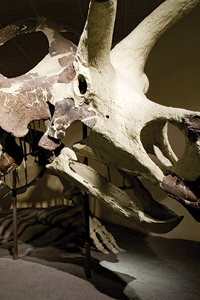 Paleontology is the study of life from the deep past through fossils of plants, animals, and other organisms that lived thousands or millions of years ago.
Paleontology is the study of life from the deep past through fossils of plants, animals, and other organisms that lived thousands or millions of years ago.
A fossil is preserved evidence of past life, and can be a body fossil (bone, teeth, leaves, or shells) or a trace fossil (footprints or coprolites, which is fossilized poop!). When paleontologists find fossils from different animals in the same layer of earth, that can mean those animals lived at the same time.
One example is the Hell Creek diorama at MPM. The exhibit shows the Tyrannosaurus rex, Triceratops, Struthiomimus, and Dromaeosaurus in one time and place because our scientists found their fossils together. Dinosaurs are just one kind of animal that paleontologists study. Some, the meat-eaters, were predators, or animals that eat other animals. Others, largely the plant-eaters, were prey, or animals that predators eat.
Herbivores (plant-eaters)
- Walked on four legs - Some four-legged dinosaurs’ heads were low, so they ate plants near the ground. Some had long necks and ate food high in trees.
- Flatter, wider teeth - Helped the dinosaurs grind the plants they ate.
- Swallowed rocks to help digest food - Paleontologists call these rocks gastroliths. Some animals today exhibit the same behavior.
- Often had horns, bony skull frills, or thickened bones - Helped the dinosaur protect itself from predators.
- Thumb spikes - May have been used for food or defense.
- Eyes on the sides of their heads - Helped them keep a lookout for predators.
Carnivores (meat-eaters)
- Sharper teeth - Helped the dinosaur slice into other animals. The T. rex had serrated teeth, meaning the edges of its teeth were jagged or sawlike.
- Sharp claws - Helped meat-eating dinosaurs tear into prey.
- Walked on two legs - Helped the dinosaur run quickly to catch other dinosaurs to eat.
- Powerful legs - Helped the dinosaur run quickly to catch other dinosaurs to eat.
- Eyes on front or side of their heads - Eyes facing front helped the dinosaur focus on its prey.
Vocabulary and Definitions
Carnivore: An animal that eats meat.
Extinct: No longer in existence.
Fossils: Evidence of prehistoric life.
Herbivore: An animal that eats only plants.
Paleontologist: A scientist who studies life forms as represented by the fossils of plants, animals, and other organisms.
Turn and Talk
Use these prompts to start a conversation.
- What do you know about dinosaurs? Do you have a favorite?
- Dinosaurs ate plants, meat, or both; how did they get their food?
- Are there dinosaurs walking around today?
- Can you walk and roar like a dinosaur?
- What name would you give a dinosaur if you discovered it? (e.g. Michael-asarous, or Presley-a-tops!)
Explore MPM's Exhibit
Google Street View
Take a virtual walk through the Museum’s The Third Planet exhibit!
At Home
Paleontology Matching Game
Dino Matching Game
The Lonely Dino
Animal Cards
Word Tracing
Video Resources
MPM Untold: Dromaeosaur
Dig Into Paleontology
Dinosaur Song
Recommended Reading List
First Big Book of Dinosaurs by Catherine D. Hughes
We Love Dinosaurs by Lucy Volpin
Boy, We Were Wrong About Dinosaurs! by Kathleen Ludlinski
Bones, Bones, Dinosaur Bones by Byron Barton
Here We Go Digging for Dinosaur Bones by Susan Lendroth


